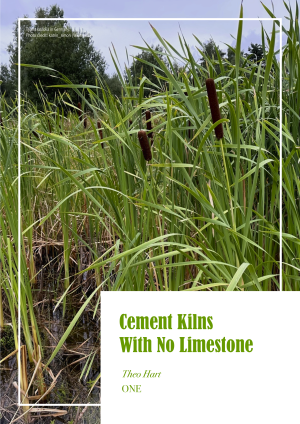 It is frequently stated that cement making is an industry hard to decarbonise. Certainly, it seems so, since one major component is lime (CaO) obtained at high heat from limestone (CaCO3) with the release of CO2 in the flue gases, making it expensive to capture.
It is frequently stated that cement making is an industry hard to decarbonise. Certainly, it seems so, since one major component is lime (CaO) obtained at high heat from limestone (CaCO3) with the release of CO2 in the flue gases, making it expensive to capture.
This process occurs in a long rotary kiln at temperatures exceeding 1400°C, where the materials present are fused into clinker. Finely ground clinker is the powdery cement familiar to us. Clay and limestone are the materials which enter the rotary kiln, and they must be an intimate mixture of fine particles when subjected to heat hot enough to fuse them. Clay is naturally comprised of tiny particles: limestone, of course, is not.
How limestone becomes fine particles begins with blasting it from a rock face so it tumbles down mainly in big chunks. These are crushed into smaller chunks, about the size of a suitcase, and smaller. A succession of other types of machinery continues the reduction steps until a fine powder is obtained. All of this obviously takes quite a lot of energy.
Limestone generally contains variable amounts of clay, and the clay may vary in composition, having more or less silica than alumina. However, the ratio of clay to lime is what matters most. The tiny limestone particles are then thoroughly mixed with clay in the proportion required to make good cement when they fuse in the kiln. Being crucial for obtaining a good product, this mixing is closely monitored and adjusted as needed.
One way to avoid much of this grinding of stone involves dissolving limestone in an organic acid and then depositing pure calcium carbonate as small particles. Acetic acid is the most likely choice. Here is one way of accomplishing this.
Charge a closed vessel with lumps of limestone, plum to peach in size, and contact them with acetic acid as a liquid or in steam. This creates calcium acetate salt with the release of CO2 from the stone. As the limestone is ancient, this is fossil-C in the CO2, now easily gathered for sequestration. Add sufficient water to obtain a salt solution convenient for the next step. If necessary, filter out particulates.
Having made a fairly strong solution of calcium acetate, mix it with a slurry of potassium carbonate to drop much, but not all, of the calcium as its carbonate. This leaves an acetate solution of both potassium and calcium. Add an alcohol to partition the solution, potassium acetate going into the upper alcohol layer. Draw it off and gas with CO2 of biological origin to obtain, once again, potassium carbonate. The process is somewhat more complex than this, but in essense what happens [British Patent 521 202].
This takes the CO2 out of the limestone and provides a finely divided pure calcium carbonate for the kiln. Depending on the type of CO2 decarbonisation being referred to, this either makes no difference or is very significant. Arguably, zero emissions may apply exclusively to CO2 where the carbon is of fossil origin.
Other Benefits for the Cement Maker
Besides not having CO2 emitted from limestone in the kiln, and not having to grind limestone very fine, the purity of the calcium carbonate can lead to whitish, even very white cement. It is impurities in the limestone that make cement look grey. The not-quite-white cement has many decorative possibilities.
Also, in small particles, pure calcium salts of organic acids may enter the preheater to the kiln in the same place. Once in the kiln, high heat breaks them up into lime and burnable gases equivalent to the ketone of that acid. Such salts can be a source of biofuel. The longer the acid, the better in this regard: calcium butanoate would be better than calcium acetate, for example.
However, such salts are not inexpensive fuel, and cheap is what kiln operators seek. So, while feasible, that option seems unlikely in practice. But something else derived from plants is a cheap fuel for the kiln.
Before seeds fully develop, biomass may be thought of as the entire plant, or later as the rest of the plant other than its mature seeds. For present purposes, that description works. Biomass is an inexpensive material for biofuel fermentation, and large amounts are readily available.
Lignin is a component of a plant’s structural parts, the stalk and any branches mainly. Since it interferes with microbial use of biomass, removing much of it accelerates fermentation. When material removed from biomass is mostly lignin, it is typically either burnt or discarded.
Typha latifolia is a plant with a higher percentage of lignin than most others. It is known by various local names in many parts of the world, but is usually referred to as cattails or bulrushes in English.
Mostly considered a problem weed, the plants prefer shallow water along the edge of ponds or streams and grow thickly, crowding out other plants. They are perennials, edible in all their parts (if you are desperate for food). With adequate water for the whole season, they can produce large amounts of biomass. Cropland would not be involved.
Hot aqueous acetic acid on biomass removes some material but mainly creates more of itself from the acetyls on the xylan. The resulting solution could be sent to the limestone lumps as described above to release CO2 and produce calcium acetate.
The biomass could then undergo an ammonia soak for some time to remove about half of the lignin. More lignin would be removed more quickly using ethylamine instead, as it is much more alkaline. Since it distils at 17 °C, it is readily recovered as vapour smelling a bit like fish.
This material is readily fermented to yield products having no connection to cement making. The lignin can be sent to the kiln operator to burn in the central flame of the kiln, similar to powdered coal.
Theo Hart





